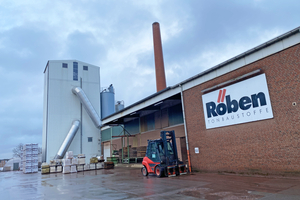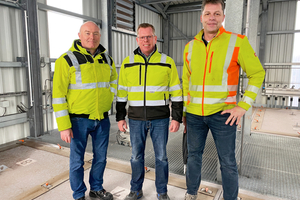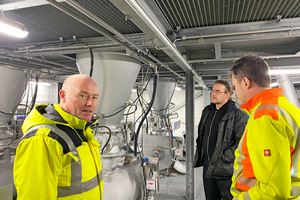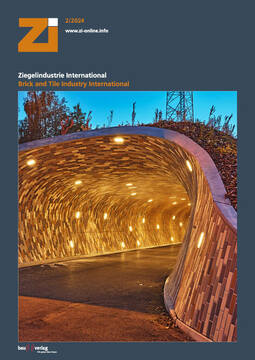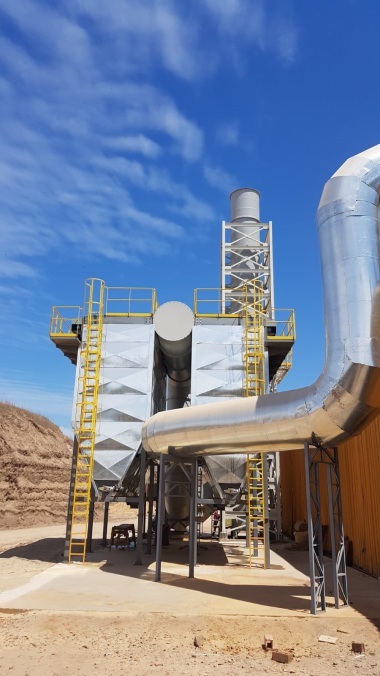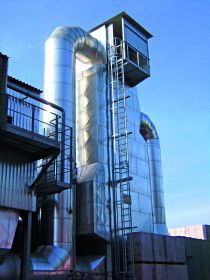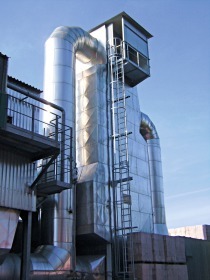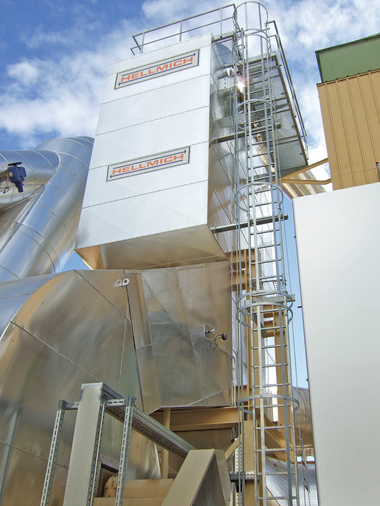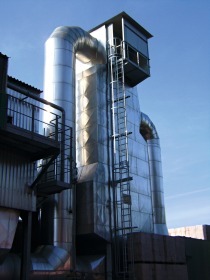Ready for the future - On the installation of two new flue gas filter systems from Hellmich GmbH & Co. KG at a Röben Tonbaustoffe GmbH site
At Germany‘s largest clinker brick plant, Röben’s plants 2 and 4 near Bad Zwischenahn (Querenstede), the company has used the time of major corona-related restrictions to make production more future-proof. The entire exhaust filter systems were replaced. The new filter system is not only designed for long-term use, but also allows scope for adaptation to future stricter standards. It is also adapted to the special requirements of the plants. After all, around 200,000 standard formats are produced at the site in Querenstede. That‘s around 35 million pieces per plant per year, totalling around 70 million.
In the run-up to Christmas, ZI editor-in-chief Victor Kapr travelled to the plant near Oldenburg to talk to Röben managing director Ralf Borrmann, plant manager Steffen Hennicke and Christoph Hellmich from Hellmich GmbH & Co. KG about emissions standards, filters and conversions during ongoing operations.
Reasons for replacing the filter system
When asked about the reasons for replacing the flue gas cleaning systems, Ralf Borrmann lists two decisive factors. On the one hand, the clay used at this site could not be utilised without a complex flue gas cleaning system. The company‘s own clay pit supplies Lauenburg clay, a type of clay that can be found throughout the entire Lower Saxony plain. It is characterised by its young age of around 60,000 years. The clay components are only slightly weathered, which is why there is a lot of organic matter in the clay. In addition to fluorine and chlorine compounds, the Lauenburg clay also contains a very high proportion of pyrite. Accordingly, the raw gases from the firing of such clay products contain large quantities of sulphur, around 2,000 - 3,000 mg/m³ of sulphur oxides. The limit values of the TA Luft (Technical Instructions on Air Quality Control) are currently 500 mg/m³.
On the other hand, a supply bottleneck had become apparent for the sorbent used until then. The bulk layer filters operated before the conversion used a granulate of calcium hydroxide and calcium carbonate as a sorbent. Granulation was essential, as the increased sulphur content could only be dealt with using particularly large surface areas and reactive material. In Germany, only one company produced this sorbent in a single plant. After this plant was converted from electrostatic precipitators to dust filters in 2018, the process temperature for drying the granulate could no longer be achieved. The resulting material quality meant that the limit values in Querenstede could no longer be met. Alternative sorbents or granulates were not available in the required quantities and were comparatively expensive, reports Borrmann. A new method of waste gas purification therefore had to be set up in the medium term.
Decision in favour of hose filter system from Hellmich
Together with Hellmich GmbH & Co. KG - flue gas cleaning and dedusting technology from North Rhine-Westphalia, Borrmann continues, they discussed solutions. Christoph Hellmich suggested a hose filter system as a viable long-term replacement. These systems are used when a counter flow system reaches its performance limits with high raw gas values. The entrained flow process with subsequent filtration makes it possible to separate high SOx concentrations with simultaneously high chlorine and/or dust concentrations, as well as hydrogen fluoride. With a view to the future of the site, Röben then decided to replace the flue gas cleaning systems of both furnaces in Plant 2 and Plant 4. The contract was awarded in December 2019.
Installation
The installation phase of the new system was very demanding, says Borrmann. This is because the conversion took place during ongoing production operations. This was in line with Röben‘s corporate philosophy that the ovens are not switched off if possible. Both plants have been running without interruption since 2008, and there was no deviation from this even during the economic boom in 2020 and 2021. Borrmann summarises the resulting challenges as follows: „It’s like replacing the catalytic converter and the entire exhaust system of your car while driving on the motorway.“
The safety of the staff in particular caused him some sleepless nights. In order to reduce the danger and prevent the fitters from standing directly in the stream of flue gas, an emergency chimney was built for the conversion in order to divert the flue gases via the roof. Nevertheless, the operation was challenging and stressful. With flue gases at temperatures of 200 degrees, a gas mask and protective equipment were essential. To remove the pipework and lay the new connections, only the burners were switched off and the thrust stopped. Borrmann therefore expressly praises the efforts of Christoph Hellmich and his fitters as well as of his own team: „That was a great achievement. Really commendable.“
The first system in plant 2 was put into operation in December 2020, system 2 in plant 4 in May 2021.
Performance and description of the new system
Borrmann is also full of praise for Hellmich‘s systems. „They are top of the range in terms of technology and can be operated with an accuracy of 10 milligrams.“ Steffen Hennicke adds that the new sorption material, pure calcium hydroxide, is much more effective at separating sulphur. Filtering based on the entrained-flow principle is achieved by feeding the material into the flue gas stream, where it binds the sulphur, chlorine and fluorine particles. The flow of binding agent and bound particles then goes into the hose filters, where it is separated as reaction lime.
Christoph Hellmich explains the details of the operating mode: The hose filter system installed here is a variant where only lime hydrate (Ca(OH)2) is dosed in a dry state using a frequency-controlled dosing screw. This allows sulphur emissions of up to 1200 mg/m³ to be captured. Chlorine can also be filtered well in this way.
However, the site in Querenstede, with an average of 2,400 mg/m³ and in individual cases up to 3,000 mg/m³ of sulphur in the exhaust gas, requires a significantly higher separation capacity. The system therefore has two special features. Firstly, up to 80 per cent of the sorbent is saturated by recycling the treated material in a circuit. Secondly, the reactivity of the sorbent is increased by conditioning. The circulated material is removed from the system and fed into a mixing drum. Water is injected to produce a moist, powdery and warm sorbent material with high reactivity. The process balances itself out depending on the amount of fresh material fed in and the amount of dust arriving in the filter system.
However, the main challenge is to ensure that such a system runs reliably and stably. According to Hellmich, this is why a continuous mixer with conditioning was developed 20 years ago and has since been modified. This works with certain quantities and allows predictable performance values. If the volume flow or the quantity of pollutants to be separated doubles, the number of mixers can simply be doubled. Four continuous mixers have therefore been installed in Querenstede.
A minimum speed of more than 20 m/s must be achieved for stable operation so that the material is carried along in the airflow. If the thrust of the flue gas flow changes, e.g. due to a different operation of the furnace, this can be compensated for by recirculating part of the flue gas and the minimum speed can be maintained.
Therefore, as Plant Manager Hennicke adds, the key parameters for flue gas cleaning are the thrust velocity, i.e. the amount of flue gas per unit of time, and the combustion process, i.e. the amount of pollutants. „To adapt to changing parameters, we vary the newly added quantity of sorbent. For example, if I know that a lighter burn-off is imminent and the thrust rate is going down, I adjust the amount added three or four days in advance. This happens in kilogramme steps. We also ramp up early in the same way to avoid oversaturation.“
Borrmann adds: „These systems require considerably more effort. It was easier with the earlier fluorine cascades. The sorbent simply trickled through, we just had to make sure that the storage tanks were full. The current system consumes more electricity and also water, which is due to the pressure difference and the high separation capacity. An expert is needed to look after both systems.“
In contrast, the disposal of the separated reaction lime is very simple. This can be used as a fertiliser and is recognised and regularly tested as a fertiliser by the Chamber of Agriculture and the Trade Inspectorate. Röben works together with a contractor who processes the fine powder for use as fertiliser.
Compared to the old filter system, the amount of fertiliser required is significantly lower. Each oven now consumes approx. 2.5 tonnes of sorbent per day or 910 tonnes per year, in total approx. 1,820 tonnes. With the old system, sorbent consumption was 4,000 to 5,000 tonnes per year. In addition, there are several suppliers for the required hydrated lime, so that supply bottlenecks are ruled out. However, hydrated lime is significantly more expensive than the granulate previously used.
Special features of the plant in Querenstede
Borrmann adds: „It wasn‘t easy at first to adjust the system to the special, reducing firing that takes place here.“ The furnace has a very complicated behaviour. The firing takes place with a locally reducing atmosphere. During the reduction period, the process air is kept stationary in the reduction zone in order to create colour effects. In order to achieve a certain play of colours across the kiln car cross-section, something special is done: although the entire kiln car is fired in a reducing atmosphere, one or two stacks can be fired in an oxidising atmosphere by means of the operating mode. „That‘s why we have to keep the pressure of the flue gas passes very stable. The whole system is highly sensitive, so everything has to fit perfectly. Because the furnace determines the process, the hose filter must not influence the mode of operation or the furnace operation. That was a learning curve for both us and the Hellmich company.“
Costs
The costs for both systems totalled approx. €5 million. In addition to delivery, this includes installation, demolition of the old systems, foundations and peripherals. By way of comparison, Hellmich explains that the costs of the previously used fluorine cascade technology were only around a third. However, such a system could not cope with the concentrations of pollutants in Querenstede.
Assessment
Borrmann emphasises that the new system is the only way to ensure stable compliance with the plant‘s exhaust gas limit values and also to ensure future reductions in limit values. „We are very satisfied with the way it works and the principle. For me as the main person responsible, the best news from the system is no news. If the system runs smoothly, I am satisfied.“ Plant manager Hennicke adds: „Of course, you have to adjust to different switching points and acceleration values at the beginning with a new system. But we managed this quickly and well thanks to excellent cooperation.“
Further climate protection measures at Röben
According to Borrmann, the new exhaust gas filter system fits in with the ongoing measures at Röben to intensify climate protection.
The company has been successfully practising energy management since 2012. Initially, the main focus was on optimising the systems and their power consumption. Now they are trying to make process engineering processes more efficient and utilise the waste heat. The next step will concern the operating masses. The Querenstede‘s own clay is responsible for a third of the CO2 costs. That is why the company is already looking for lime- and carbonfree clay resources. According to Hennicke, this could even reduce the need for flue gas cleaning. Against this background, the new, flexibly adjustable flue gas filter system is particularly future-proof, emphasises Borrmann.

